

 |
 |
Shintaro Okazaki
Universidad Autónoma de Madrid, Spain
Luiz Miguel Renda dos Santos
Universidade Estácio de Sá, Brazil
The objective of this study is to examine factors influencing e-learning adoption and the moderating role of gender. This study extends the technology acceptance model (TAM) by adding attitude and social interaction. The new construct of social interaction is applied to the South American context. Gender effects on e-learning adoption from educators’ perspectives have seldom been explored. The data collection takes place in three major Brazilian universities. In total, 446 faculty members responded to the questionnaire. Our structural equation modeling reveals that ease of use and perceived usefulness are significant antecedents of attitude, which in turn affects intention. However, unlike the original TAM, perceived usefulness is not a direct driver of intention. In terms of moderation, gender affects three relationships: (1) ease of use –› perceived usefulness; (2) perceived usefulness –› attitude, and (3) intention –› actual behavior. The analysis is carried out in a single country; thus, caution should be taken in generalization of the results. The findings will help academics, educators, and policy makers to better understand the mechanism of e-learning adoption in Brazil.
Keywords: BRIC; e-learning; gender; technology acceptance model; social interaction
The purpose of this article is to extend our knowledge on e-learning in three ways. First, this study broadens one of the most widely used behavioral models, technology acceptance model (TAM). In doing so, we combine qualitative and quantitative methods to seek confirmation as well as justification of the TAM extension. We believe that this combined methodology improves the study’s validity and implications. Second, it also aims to examine the moderating effect of gender. Gender effects in new technology acceptance in a TAM context have been explored in information systems literature (e.g., Carr, 2005; Venkatesh & Morris, 2000), but the moderating role of gender in open and/or distance learning is still an understudied topic (Ong & Lai, 2006). Despite its importance in computer-mediated environments, educational literature seems to lack sufficient evidence in this regard. This study tries to fill this research gap. Third, the data collection takes place in one of the most emerging markets: Brazil. Brazil is considered one of the rising economic powers, as part of BRIC (Brazil, Russia, India, and China). Nonetheless, educational research on Brazilian higher education has still been scarce. Our review of literature on e-learning found three studies that examine computer adoption in Brazilian elementary schools (D’Assumpção-Castro & Alves, 2007; Fidalgo-Neto et al., 2009; Martins, Steil, & Todesco, 2004), while no research has been published on Brazilian university distance learning adoption. Thus, there is a clear lacuna in our knowledge of this field in this country. While the mere scarcity of published research may not necessarily make it worth investigating, we believe that both theoretical (TAM and gender) and practical (emerging market) justifications would not only justify the scholarly value, but also grant this research a unique position in the literature.
This study is organized as follows: We first explain TAM and gender as primary theoretical tenets. Then, we attempt to extend TAM based on a qualitative study, which leads to our formal hypotheses and research question. Next, we describe the methodology in detail and report the results of model validation. In closing, some important limitations are recognized, while concluding remarks are explicated. The article closely follows this structure.
Technology acceptance model (TAM) is one of the most widely used behavioral models. It was specifically developed to predict individual adoption and use of new information technology or information systems (Davis, 1989). TAM uses theory of reasoned action (TRA) as a theoretical basis, but replaces many of TRA’s attitude measures with two technology acceptance measures, ease of use (EOU) and perceived usefulness (PU). The central idea underlying TAM is that it is EOU and PU, not attitude, that ultimately determine a person’s behavioral intention to use an IT (Davis, Bagozzi, & Warshaw, 1989). PU refers to the extent to which a prospective user believes that using a specific IT will improve his or her job performance, while EOU refers to the extent to which a user expects the use of a specific IT to be relatively free of effort (Davis, 1989. Because effort is a finite resource that a person may allocate to the various activities for which he or she is responsible (Radner & Rothschild, 1975), TAM posits that, all else being equal, an application that is perceived to be easier to use than another is more likely to be accepted by the user. In TAM, PU is seen as being directly impacted by EOU, with intention to use serving as a mediator of actual system use (Figure 1) (Davis, 1989).
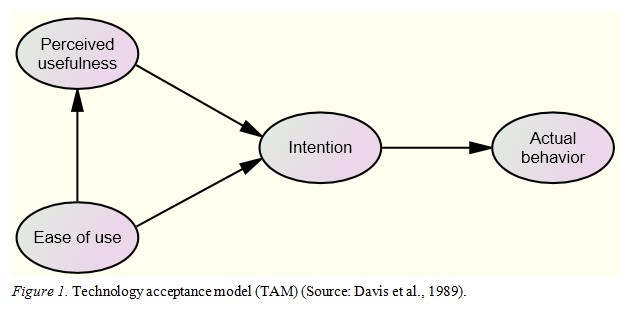
TAM has received extensive empirical support through validations, applications, and replications across a diverse range of information technology, including the mobile device (e.g., Bruner & Kumar, 2005; Luarn & Lin, 2005; Wu & Wang, 2005). As a result, it is reported that TAM consistently explains approximately 40% of the variance in individuals’ intention to use an IT and actual usage (Venkatesh & Davis, 2000).
In general, attempts to extend the TAM have taken one of three approaches: introducing factors from related models, introducing additional or alternative belief factors, and examining antecedents and moderators of PU and perceived EOU (Wixom & Todd, 2005). For example, Doll et al. (1998) argued that the TAM should include the influence of social/personal factors. Other scholars suggested integrating contingency variables into the TAM framework, including human factors, emotional factors, and social influence factors. Venkatesh and Davis (2000) maintained that research to date had not studied how perceived playfulness fits into the nomological network of TAM. Venkatesh and Morris (2000) viewed anxiety as a determinant of process expectancy, such as perceived EOU. Other scholars have proposed that perceived computer playfulness and anxiety have significant effects on perceived EOU. Lu et al. (2003) proposed social influence to predict PU toward wireless Internet via mobile devices (WIMT) and concluded that social influence can promote and facilitate the acceptance of using WIMT.
In a context of online gaming adoption, Hsu and Lu (2004) added social influence and flow experience, which are conceptualized as antecedents of both attitude and intention. They found perceived EOU to be the most important determinant of attitude, but PU plays a minor role in this regard. In addition to flow experience, Ha et al. (2007) incorporated perceived enjoyment, perceived attractiveness, and perceived lower sacrifice as antecedents of attitude. Their findings show that the effect of perceived enjoyment is the most solid, while PU has no impact on attitude formation in a context of online gaming.
Gender differences have been explored across a diverse range of social science disciplines, including the computer-mediated environment. It appears that much research “has consistently demonstrated that gender inequalities define professional and scholarly electronic communication and that men are over-represented in electronic communities” (Sierpe, 2005, p. 131). However, gender differences in e-learning remain largely understudied.
From a theoretical point of view, gender is often used as a part of the social and cultural meanings associated with developing a marketing strategy because the male-female dichotomy is the most fundamental dichotomy in society (Prakash & Flores, 1985). Moreover, we are expected to have learned gender roles since childhood. Boys and girls are expected to acquire not only sex-specific skills, but also sex-specific self-concepts and personality attributes, which enable them to feel masculine or feminine, as defined by a given culture (Barry, Bacon, & Child, 1957).
Gender schema theory posits that consumer behavior is a result of gender-based schematic processing (Bem, 1981). A schema is a cognitive structure that organizes and guides one’s perception. A schema-based explanation of consumer response suggests that information about the gender and the event are accessed from memory. After comparison with the schema, the new information is encoded and assimilated into gender-linked associations that itemize appropriate gender-based behaviors. These behaviors become a gender schema against which individuals evaluate their own behaviors in order to regulate their attitudes and behaviors (Bem, 1981). According to this theory, male schemas are associated with success and achievement to a higher degree than female schemas (Firat & Dholakia, 1998).
Self-construal theory explains that gender-based information processing differences result from one’s self-system, or self-construal. According to this theory, women view themselves as interdependent with others (interdependent self-construal) and thus tend to focus on establishing and maintaining relationships with people and social contexts. In contrast, men view themselves as independent of others (independent self-construal) and tend to have more individualistic goals. In addition, men are less concerned with belongingness or affiliation, thus concerns about society, family, and other people are secondary for men. Other streams of research indicate biological differences in the brain scheme. Meyers-Levy (1999) argues that females are likely to rely on left-hemisphere processing, which concerns the specificities and intricacies represented by stimulus information, thus they will eventually seek emotional benefits. In this respect, Phillip and Suri (2004) found that American women are more emotionally attached to their possessions than males and are more likely than men to favorably perceive promotional e-mails that include hypertext links for additional information.
For a successful model extension, a study must achieve two essential goals: (1) confirmation of the construct adequacy, and (2) identification of additional constructs. To this end, we conducted in-depth interviews with 63 professors who work at three Brazilian universities. One of the researchers contacted the candidates by e-mail, requesting their participation in the study. A brief summary of the study objectives and background was provided. Candidates were told that the content of the interviews would only be used for academic purposes and their complete anonymity was guaranteed. Also, they were informed that they could obtain a summary of the study upon its completion. When candidates agreed to the interviews, appointments were scheduled by e-mail. Interviews were conducted in their workplace with an average duration of 58 minutes.
Open-ended questions were employed to encourage a detailed, but flexible discussion of the topics. Each time an interview was completed, transcripts were generated and coded in light of two main objectives: (1) confirmation of the TAM constructs and (2) identification of potential factors. During the coding, we conducted a detailed, line-by-line analysis to generate initial conceptual categories and to suggest relationships among categories (Charmaz, 2006). The results were constantly compared to make sure that interviewees’ responses were synthesized into the most significant and frequent categories. We continued this process, interviews, coding, and constant comparison, until we reached a point where new interviews no longer sparked new insights (Charmaz, 2006).
As a result of this qualitative study, we did confirm that all TAM constructs were relevant in e-learning adoption. At the same time, we found two additional dimensions that need to be complemented: social interaction and attitude. Here, social interaction reflects an expectation that e-learning systems would increase close interactions among peers and faculty members. Many respondents pointed out that one of the most important benefits in e-learning adoption is to gain a greater level of interaction with their students and peers. In addition, affective feeling, “liking,” was undeniably important because the respondents tended to associate their adoptive behavior with not only cognitive (e.g., teaching efficiency, knowledge sharing) but also emotional (e.g., positive affect, motivation, shared enjoyment) consequences. Davis et al.’s (1989) original TAM did include attitude as an antecedent of behavioral intention, although it was deleted due to its insignificant effect in their empirical study. In our case, we decided to include attitude because there was sufficient evidence that affective feeling is a good reason to drive intention.
Our proposed model is shown in Figure 2. Our H1 and H2 posit that attitude is induced by EOU and PU, respectively. In turn, H3 contemplates a causal relationship between EOU and PU in that the former determines the latter. These relationships have been widely documented in the TAM literature (e.g., Bruner & Kumar, 2005; Lu et al., 2003; Luarn & Lin, 2005). By the same token, prior research on attitudinal model suggests that attitude is hypothesized to drive behavioral intention (Ajzen, 1991), while, in light of Davis et al. (1989), PU is a direct determinant of intention, which in turn determines actual behavior. Thus:
H1: EOU directly and significantly affects attitude.
H2: PU directly and significantly affects attitude.
H3: EOU directly and significantly affects PU.
H4: Attitude directly and significantly affects intention.
H5: PU directly and significantly affects intention.
H6: Intention directly and significantly affects actual behavior.
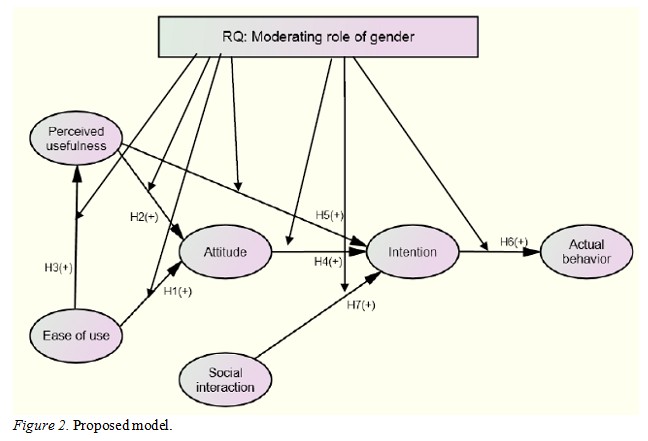
We posit that social interaction could be an important driver of intention for two reasons. Prior research on electronic word-of-mouth indicates that people’s sense of belonging is one of the most fundamental motivations to participate in information exchange behavior (Hennig-Thurau & Walsh, 2004). Second, Algesheimer, Dholakia, and Herrmann (2005) suggest that members of a brand community are actively engaged in social interaction building within the network. Therefore:
H7: Social interaction directly and significantly affects intention.
Finally, in light of the gender-related theories reviewed above, this study attempts to address the moderating effect of gender in e-learning adoption. Due to the complexity and a lack of empirical evidence on gender and e-learning, we formulate a research question instead of formal hypotheses:
RQ: How does gender moderate the relationships among the proposed constructs of the model?
In the next section, we describe the methodology used in the study in detail.
The proposed model was tested and validated by an empirical survey. We collected data from consumers in Brazil, in which the e-learning penetration has been on the rise. A convenient sample was used in three large Brazilian universities. In total, 600 faculty members, both part-time as well as full-time members, were approached by e-mail and invited to participate in the web-based survey. In total, 468 respondents completed the questionnaire. Twenty-two responses were incomplete and 446 responses were thus usable. Therefore, the effective response rate was 74%.
The survey instrument consisted of three parts. The first part included gender, position, university teaching experience, e-learning usage experience (Moodle, TelEduc, or in-house systems), and PC usage experience, among others. The second part explained the purpose of the study to the respondents then started the questions associated with the main constructs of the proposed model. All the constructs were measured by multiple-item, seven-point scales from “not at all” (1) to “very much” (7), with “neutral/cannot answer” (4) as an anchoring point. The majority of the items were adapted from prior e-commerce and e-learning research (see Table 1; Premkumar & Bhattacherjee, 2008; Liao, Chen, & Yen, 2007; Richardson & Swan, 2003; Taylor & Todd, 1995), while actual behavior was measured by a mean value of four relevant usage frequencies. When the original items were translated from English to Portuguese, translation-backtranslation was conducted in an attempt to ensure semantic equivalence (Craig & Douglas, 2005). The wording of the translated items was then discussed and evaluated by a panel consisting of two bilingual researchers.
To examine the direct links between the constructs depicted in our proposed model, we followed the two-step approach of Anderson and Gerbing (1988). In this approach, the estimation of a CFA precedes the simultaneous estimation of the measurement and structural models. A CFA was built with 13 latent constructs and a total of 45 variables with AMOS 18.0. All items loaded onto the corresponding constructs with a high level of coefficients whose t-values were all statistically significant at p < 0.001. As in the pretest, multiple indexes were used to assess the goodness of fit of the overall model. The CFA produced the following results: χ2 = 310.31 (df = 155), CFI = 0.98, IFI = 0.98, TLI = 0.97, and RMSEA = 0.047.
The construct validity was assessed using CR. As shown in Table 1, the scores for all the constructs exceeded a threshold point, 0.70, which is a minimum recommended by prior research. An even more stringent criterion is the average variance extracted (AVE). Hair et al. (2006) suggest that a reliable construct should meet at least 0.50. All constructs met this criterion, except actual behavior (0.43). Overall, we therefore deemed the convergent validity to be satisfactory.
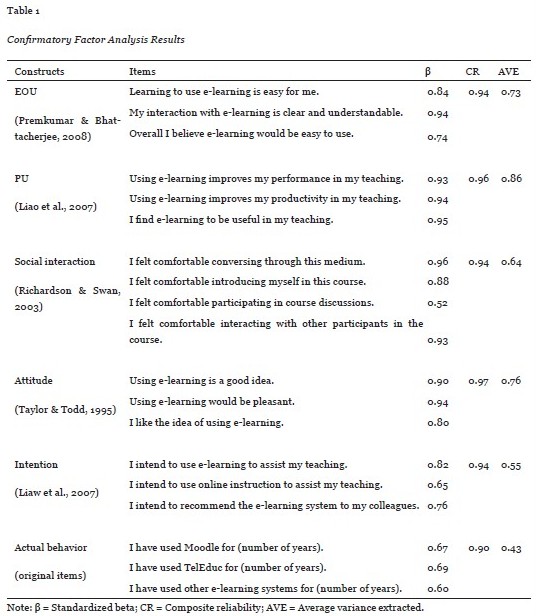
Next, with two constructs being sufficiently and psychometrically distinct, the square root of AVE of one construct should be greater than the construct-to-construct correlation between the two. This criterion was met for all the combinations, thus the discriminant validity of the measurement model was satisfied.
The structural paths on the hypothesized relationships between the proposed constructs were examined for the full sample with maximum likelihood method using AMOS 18.0. Most of the indexes indicate an adequate model fit: χ2 = 460.94 (df = 162), CFI = 0.96, IFI = 0.96, TLI = 0.95, and RMSEA = 0.064. Therefore, it was judged that the multiple indexes sufficiently justify the adequacy of the model’s fit to the sample data.
The structural model results are shown in Table 2. In our H1 and H2, we posit that EOU and PU determine attitude, respectively. Our results indicate that both paths are statistically significant. But the path from perceived usefulness to attitude (standardized β = 0.58) is much stronger than that from ease of use to attitude (standardized β = 0.16). Thus, both H1 and H2 were supported.
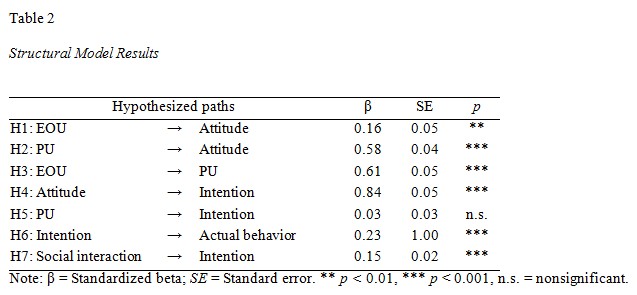
In H3, we contemplate the causal relationship between ease of use and perceived usefulness. According to our structural model, this rang true with high standardized β (0.61). Thus, H3 was supported. By the same token, H4, which predicts a positive and direct relationship between attitude and intention, received support from our data (standardized β = 0.84).
H5 posits that perceived usefulness directly determines intention, as was proposed in the original TAM. Nonetheless, our results indicate the contrary because this path was not statistically significant. Therefore, H5 was rejected.
In H6, as much research on behavioral theory indicates, intention is proposed to be an antecedent of actual behavior. This path was strong and statistically significant, supporting H6.
Finally, H7 states that social interaction is a significant predictor of intention. Our results echo this proposition, even though its standardized β is somewhat modest (0.15).
Next, in order to address our RQ, we performed a moderation analysis for gender. To this end, we first ran a multigroup CFA to check invariant structures between the two models: male and female respondents. The chi-square difference in measurement weights between the two models was not statistically significant (p = 0.26), thus proving that the model works invariantly for the male and female respondents.
Based on the invariance structures, we performed a multigroup structural model analysis. In light of Bagozzi and Yi (1998), individual estimations of the baseline model were carried out for each model. The fit indexes suggest a good fit for both models with all the structural parameters being significant at p < 0.05, except one between PU and intention. On this basis, a multigroup structural model analysis was carried out with AMOS 18.0. Following Bagozzi and Yi (1998), the multigroup baseline model was estimated with the male and female respondents simultaneously, without placing any equality constraints on the hypothesized paths. Their fit indexes serve as initial comparison points in addressing whether the proposed structural relationships would hold in the same way across the three cluster groups. Next, in the constrained model, equality constraints were specified on all the structural paths. The difference in the chi-square values between the constrained and unconstrained models was calculated and tested by t-values with a statistical significance at p < 0.01. Table 3 shows the results. As seen clearly, there are three paths whose differences between the male and female models were statistically significant: (1) EOU – › PU; (2) PU – › attitude, and (3) intention – › actual behavior.
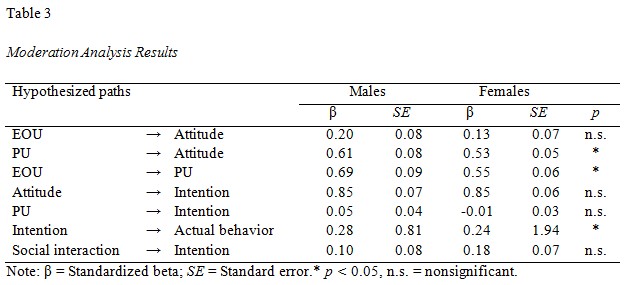
As is always the case, this research suffers from a few limitations, which we must recognize for our objectivity. First, our sample was a convenient sample who volunteered to participate in the survey. Thus, any generalization based on this study should be treated with caution. Moreover, our sample consisted of faculty members teaching in private universities. However, important differences are said to exist between public and private institutions in Brazil, which this research does not take into account. Thus, future research would benefit from interviews of public academic institutions’ staff to paint a complete picture of the acceptance of e-learning in Brazilian higher education institutions. Second, the moderation hypotheses are not exclusive to the three variables (gender, professional category, and usage experience) we proposed. Other relevant factors, such as personal experience and propensity of Internet usage, educational background, and age, may influence the relationships among the constructs. In particular, it will be interesting to examine a relationship between e-learning adoption and computer self-efficacy, which would further improve the validity of the study.
This study extends TAM through the addition of attitude and social interaction and examines e-learning adoption in Brazil. Our key interest lies in the question of how gender affects the hypothesized relationships among the constructs.
Our findings suggest that the extended TAM fits our data fairly well, but the relationship between perceived usefulness and intention was negligible. This departs from the original propositions made by Davis et al. (1989) who contemplate the direct influence of perceived usefulness on intention. At the same time, our extended model recaptures the importance of attitude, which was determined to be irrelevant in the original TAM. In particular, our structural equation modeling results suggest that perceived usefulness is a stronger predictor of attitude compared with ease of use.
Second, the extension of TAM, which closely follows the original model, provides additional evidence of TAM’s explanatory power. This model has been replicated in different countries. Our study proves that this model could be safely extended and replicated in a Latin American context. In our study, the rigorous translation-backtranslation process was adopted, which must have increased the semantic equivalence of the construct items. In this light, future research should apply or adapt the present model in other Latin American countries where e-learning adoption becomes a key issue in higher education markets.
Third, our moderation analysis reveals that gender does affect some of the causal relationships. In particular, our results indicate that male respondents perceived the path from perceived usefulness to attitude much more strongly compared with their female counterparts. This is also the case for the path from ease of use to perceived usefulness. These results seem consistent with prior research that found (1) females’ greater reliance on ease of use due to their lower level of computer literacy and (2) males’ greater emphasis on perceived usefulness in determining behavioral intention (e.g., Carr, 2005; Ong & Lai, 2006; Venkatesh & Morris, 2000; Yuen & Ma, 2002). In addition, perhaps females are more prone to seek reasons to gain emotional, rather than rational, benefits (i.e., attitude). It seems that both ease of use and perceived usefulness are the specificities and intricacies represented by stimulus information because, as Meyers-Levy (1989) argues, females are likely to rely on left-hemisphere processing. On the other hand, males are more consistent in terms of the intention –› actual behavior link, while females are less likely to make behavioral decisions in terms of e-learning adoption.
Our research results provide some practical implications that would assist the development of e-learning methods in higher education institutions in Brazil. A fact that social interaction directly and significantly affects intention among both males and females suggests that social networking sites could be a useful tool to exchange information among faculty members. In fact, the use of Facebook or LinkedIn has become increasingly popular among higher education faculty. According to a recent survey, nearly 85% of faculty have a Facebook account, two-thirds are on LinkedIn, and 50% are on Twitter (Wakefield, 2012).
Furthermore, Academia.edu, one of a growing number of networking sites designed specifically for scholars, has attracted 1.2 million registered users, where users are engaged in organizing their research, creating personal profiles, and searching for people with similar scholarly interests (The Chronicle of Higher Education, 2012). With these tools, universities could stimulate or encourage motivations to use e-learning by explicating its usefulness as well as ease of use. In this regard, females may be more attracted by social network-based web activities compared with males (Barnett, 2012), although our moderation results indicate no significant difference on the path from social interaction to intention. This issue on the use of social networking sites, gender, and e-learning diffusion may be an interesting topic to explore in the future.
The authors appreciatively acknowledge the financial support provided by a grant from the Spanish Ministry of Science and Innovation (National Plan for Research, Development and Innovation ECO2011-30105) for preparing this article.
Ajzen, I. (1991). The theory of planned behavior. Organizational Behavior and Human Decision Processes, 50(2), 179–211.
Algesheimer, R., Dholakia, U. M., & Herrmann, A. (2005). The social influence of brand community: Evidence from European car clubs. Journal of Marketing, 69(7), 19–34.
Anderson, J.C., & Gerbing, D.W. (1988). Structural equation modeling in practice: A review and recommended two-step approach. Psychological Bulletin, 103, 411-423.
Bagozzi, R.P., & Yi, Y. (1998). On evaluation of structural equations models. Journal of the Academy of Marketing Science, 16(1), 74-94.
Barnett, E. (2012, June 26). Women ‘more attracted to social networking sites’. Independent ie. Retrieved from http://www.independent.ie/business/technology/women-more-attracted-to-social-networking-sites-3150898.html.
Barry, H., Bacon, M.K., & Child, I.L. (1957). A cross-cultural survey of some sex differences in socialization. Journal of Abnormal and Social Psychology, 55, 327-332.
Bem, S.L. (1981). Gender scheme theory: A cognitive account of sex typing. Psychological Review, 88, 354-364.
Bruner, G.C., & Kumar, A. (2005). Explaining consumer acceptance of handheld Internet devices. Journal of Business Research, 58(5), 553-558.
Carr, D. (2005). Contexts, gaming pleasures, and gendered preferences. Simulation & Gaming, 36(4), 464-482.
Charmaz, K (2006). Constructing grounded theory: A practical guide through qualitative analysis. Sage Publication: London.
Craig, C.S., & Douglas, S.P. (2005). International marketing research (3rd ed.). New York: John Wiley and Sons.
D’Assumpção-Castro, M.F., & Alves, L.A. (2007). The implementation and use of computers in education in Brazil: Niterói city/Rio de Janeiro. Computers & Education, 49(4), 1378-1386.
Davis, F.D. (1989). Perceived usefulness, perceived ease of use, and user acceptance of information technology. MIS Quarterly, 13(3), 319-339.
Davis, F.D., Bagozzi, R.P., & Warshaw, P.R. (1989). User acceptance of computer technology: A comparison of two theoretical models. Management Science, 35(8), 982-1003.
Doll, W.J., Hendrickson, A., & Xiandong, D. (1998). Using Davis’s perceived usefulness and ease-of-use instruments for decision making: A confirmatory and multi-group invariance analysis. Decision Science, 29(4), 839-870.
Fidalgo-Neto, A.A., Tornaghi, A.J.C., Meirelles, R.M.S., Berçot, F.F., Xavier, L.L., Castro, M.F.A., & Alves, L.A. (2009). The use of computers in Brazilian primary and secondary schools. Computers & Education, 53(3), 677-685.
Firat, A.F., & Dholakia, N. (1998). The making of the consumer. In A. F. Firat & N. Dholakia (Eds.), Consuming people: From political economy to theaters of consumption (pp. 13-20). London, UK: Routledge.
Ha, I., Yoon, Y. & Choi, M (2007). Determinants of adoption of mobile games under mobile broadband wireless access environment. Information & Management, 44(3), 276-286.
Hair, J.F., Black, B., Babin, B., Anderson, R.E., & Tatham, R.L. (2006). Multivariate data analysis (6th ed.). Upper Saddle River, NJ: Prentice Hall.
Hennig-Thurau, T. & Walsh, G. (2004). Electronic word-of-mouth: Motives for and consequences of reading customer articulations on the Internet. International Journal of Electronic Commerce, 8(2), 51-74.
Hsu, C.L., & Lu, H.P. (2004). Why do people play on-line games? An extended TAM with social influences and flow experience. Information & Management, 41(7), 853-868.
Liao, C., Chen, J. L., & Yen, D. C. (2007). Theory of planning behavior (TPB) and customer satisfaction in the continued use of e-service: An integrated model. Computers in Human Behavior, 23, 2804–2821.
Liaw, S. S., Huang, H. M., & Chen, G. D. (2007). Surveying instructor and learner attitudes toward e-learning. Computers & Education, 49, 1066–1079.
Lu, J., Yuk, C.S., Liu, C., & Yao, J.E. (2003). Technology acceptance model for wireless Internet. Internet Research: Electronic Networking Applications and Policy, 13(3), 206-222.
Luarn, P., & Li, H.H. (2005). Toward an understanding of the behavioral intention to use mobile banking. Computers in Human Behavior, 21(6), 873-891.
Martins, C.B.M.J., Steil, A.V., & Todesco, J.L. (2004). Factors influencing the adoption of the Internet as a teaching tool at foreign language schools. Computers & Education, 42(4), 353-374.
Meyers-Levy, J. (1989). Gender differences in information processing: A selectivity interpretation. In P. Cafferata & A.M. Tybout (Eds.), Cognitive and affective responses to advertising. Lexington, MA: Lexington.
Ong, C.S., & Lai, J.Y. (2006). Gender differences in perceptions and relationships among dominants of e-learning acceptance. Computers in Human Behavior, 22(5), 816–829.
Phillip, M.V., & R. Suri (2004). Impact of gender differences on the evaluation of promotional emails. Journal of Advertising Research, 44, 360-368.
Prakash, V., & Flores, R.C. (1985). A study of psychological gender differences: Applications for advertising format. In E.C. Hirschman & M.B. Holbrook (Eds.), Advances in consumer research (pp. 231-237). Provo, UT: Association for Consumer Research.
Premkumar, G., & Bhattacherjee, A. (2008). Explaining information technology usage: A test of competing models. Omega, 36, 64–75.
Radner, R., & Rothschild, M. (1975). On the allocation of effort. Journal of Economic Theory, 10, 358-376.
Richardson, J. C., & Swan, K. (2003). Examining social presence in on line course in relation to students perceived learning and satisfaction. Journal of Asynchronous Learning Networks, 7(1), 68-88.
Sierpe, E. (2005). Gender distinctiveness, communicative competence, and the problem of gender judgments in computer-mediated communication. Computers in Human Behavior, 21(1), 127-145.
Taylor, S., & Todd, P. A. (1995). Understanding information technology usage: A test of competing models. Information Systems Research, 6(2), 144–176.
The Chronicle of Higher Education (2012, April 29). Social networks for academics proliferate, despite some doubts. Retrieved from http://chronicle.com/article/Social-Networks-for-Academics/131726/.
Venkatesh, V., & Davis, F.D. (2000). A theoretical extension of the technology acceptance model: Four longitudinal field studies. Management Science, 46(2), 186–204.
Venkatesh, V., & Morris, M.G. (2000). Why don’t men ever stop to ask for directions? Gender, social influence, and their role in technology acceptance and usage behavior. MIS Quarterly, 24(1), 115-139.
Wakefield, K. (2012, February 27). Should professors use Facebook to communicate with students? Faculty Focus. Retrieved from http://www.facultyfocus.com/articles/trends-in-higher-education/should-professors-use-facebook-to-communicate-with-students/
Wixom, B. H., & Todd, P. A. (2005). A theoretical integration of user satisfaction and technology acceptance. Information Systems Research, 16(1), 85-102.
Wu, J.H., & Wang, S.C. (2005). What drives mobile commerce? An empirical evaluation of the revised technology acceptance model. Information & Management, 42(5), 719-729.
Yuen, A.H.K., & Ma, W.W.K. (2002). Gender differences in teacher computer acceptance.Journal of Technology and Teacher Education, 10(3), 365-382.